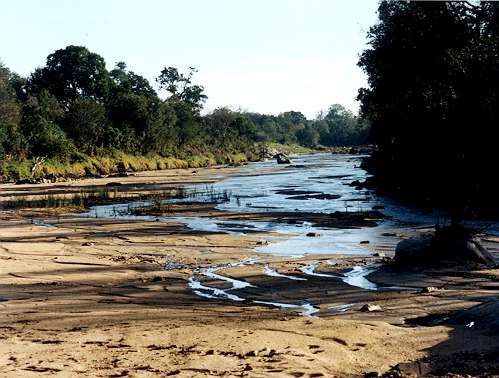
South African hikes
A walk in the wild!
The Kruger National Park Wolhuter Trail
6th - 11th June 2000
 |
South African hikes A walk in the wild! The Kruger National Park Wolhuter Trail 6th - 11th June 2000 |
|
|
| It is the season of 2000 when the winter grass in
the Cape emerges from mother earth with a vengeance and the highveld grassland turns a
characteristic shade of brown, brought on by the icy clutches of the early morning frost.
I had succeeded in persuading my Tokai "backside" neighbour Ian, to
"down tools" for a short break from his hectic electrical business schedule, for
a hike experience with a difference - a wilderness trail in the Kruger National Park,
designed, literally, to afford the visitor an ecological walking experience in the
wild.
The Wolhuter Wilderness Trail is the oldest in the park, established in 1978 in the area frequented by the legendary rangers, Harry and Henry Wolhuter. The trail camp lies about 10 km northwest of Berg-en-dal restcamp, in the transition zone between the mixed bushwillow woodlands and the Malelane mountain bushveld. After a lengthy trek in excess of 1600 km from Cape Town in an Opel Corsa, with an overnight stop in Bethlehem in the Free State, we arrived at Malalane in the Kruger National Park at 3h30 in the late afternoon. Ian, Paul and I were to meet my longtime friend and frequent co-hiker, Ralph, who had organised the trip and had been badgering me for some time since his first trail some months before and to whom I shall remain eternally grateful. |
| Day one Our arrival at Berg-en-dal had been delayed briefly by a siting of a bateleur eagle as well as a sizeable herd of buffalo crossing the road with all the time in the world, shortly after having entered the park at Malelane. In an instant, an excited Ian, bird-watcher extraordinaire, was on the cell-phone to his spouse Lily back in Cape Town. Whilst the eagle was seen perching on a branch scavenging on the head of a dead cat, whistler wife Lily was enviously "spitting blood" at the other end of the cellphone line. Once introduced to our two rangers, Thando Msomi and Kally Ubisi, and the rest of our eight-strong hiking contingent and our daypacks transferred to the Toyota Hilux trailer, we made our way to the bush camp. |
| Apart from Ralph, Ian, Paul and I, the rest of the group comprised of Ralph's sister in-law Nanette and spouse Jimmy and American couple Scott and Julie Anderson. Yellow-billed Hornbills, which we soon discovered to be somewhat plentiful in the park and lilac-breasted rollers, were spotted en route. The former, we were to discover, frequented the campsite area. Hyperactive, fairly tame yet almost comical, with a bit of an "attitude". The accommodation consisted of A-frame wooden huts complete with beds for two persons each, separate showers and toilets complete with running water and an outdoor dining area. The cook, James, prepared meals in the kitchen. A fridge was made available for the storage of drinks and liquid refreshments. Tea and coffee were available at any time of the day and evening. In short, the facilities were as comfortable was one required for the bush environment, though probably a fair bit more upmarket than what we would be accustomed to on our more conventional hikes. A makeshift fence that surrounded the camp, would scarcely be sufficient to keep some pekish carnivore at bay. |
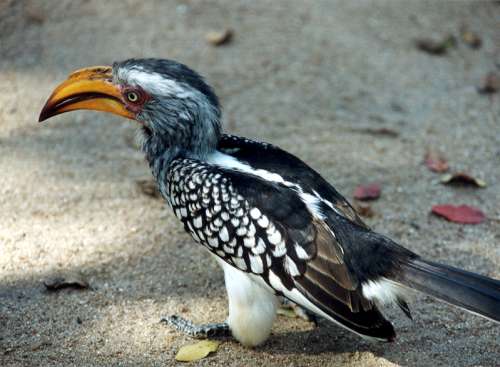 |
| We unpacked and were subsequently briefed as to the rules and protocol within the camp and the activities/schedules for the next few days. Cellphones were switched off. We were requested to complete indemnification details, basically stating that if you happen to end up as Simba's din-dins, it's not the National Park's fault. Fair game, if you pardon the pun! Thereafter we enjoyed a sumptuous chicken/rice/salad dinner made possible by the versatility of James the cook, versatility being the operative word, upon which I shall elaborate later. We settled in for the night. Ian decided that he wanted the door open to experience nature fully, as mosquito nets were provided above the beds. With the sound of a distant baboon still fresh in my ears, I dozed off as I debated the pros and cons of that manoeuvre. Deathly silence prevailed at night, though earlier I detected the unmistakable call of the wild, that of hyena, jackal and baboon. |
| Day two Up at 5h30, after the early morning ritual of coffee and rusk dunking, we departed for a destination in the bush at 6h00, before proceeding on foot. |
 |
WHITE
AND BLACK RHINO - A DISTINCTION The black rhinoceros (Diceros bicornis) is the more widespread of Africa's two rhino, has been poached to near extinction. It occurs in southern African reserves, but is now localised in East Africa, where it is most likely to be seen in Tanzania's Ngorongoro Crater. The bulkier foraging white rhinoceros (Ceratotherium simum) is no paler than its black cousin is - the 'white' derives from the Afrikaans weit (wide) and refers to its flattened mouth, an ideal shape for cropping grass. The mouth of the black rhino, a browser in most parts of its range, is more rounded with a hooked upper lip. In the Kruger National Park, the white rhino is generally seen more frequently than the black rhino. |
| Soon, what arguably appeared to be a dark chanting goshawk was spotted, resulting in a healthy debate, compounded by Ian's later observation after consulting his birdbook...... On foot we encountered a shallow pit a couple of meters in diameter, filled with what appeared to resemble normal grass manure. Thando explained that this formed part of a dominant male white rhino's customary ritual of defecating daily in the same area. After digging with its hind limbs, the white rhino, a forager, will then roam the vicinity and spread the scent, in order to mark its territory. The difference between the black and white rhino was pointed out to us (see inset). |
| Birds soon spotted included a soaring bateleur eagle, characteristically wobbling in flight, and a hovering black-shouldered kite.As the sun rose to add some warmth we enjoyed a light breakfast near the Umlambane River. This consisted of Pro-Vita, cheese, dried fried, fruit juices and the like, prepared and provided for by our hosts, which we had carried in our daypacks, in my instance along with my camera equipment. It was at this point that we examined our only means of protection in event of any life-threatening aggression shown us by an animal in the wild. Rangers are generally armed though the shooting of any animal is an absolute last resort. One well-aimed shot from a 458 Magnum shell would be sufficient to knock an elephant onto its hind quarters, we were told, though through sheer strength, buffalo have been known to take up to 35 minutes to die. But the safety record speaks for itself - in the entire wilderness trail operations since 1978, no one had ever been seriously injured or killed. Incidents have resulted in a couple of minor injuries and snakebites. Discipline is the order of the day. All hikers follow in single file behind the trackers. The trackers are well trained and have to pass a level three course with the Field Guides Association of South Africa. |
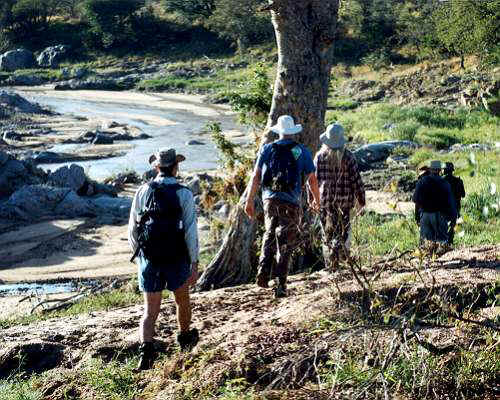 |
| Our attention focussed once more on the ecology.
Thando pointed out a strangling fig tree, a parasite, which straddles the upper
sections of the jackal berry tree, gradually killing its host in time. Jackal and
mongooses feed on the jackal berry tree, to be found near rivers. A huge
leadwood tree with light lower trunk shading to dark in the upper region adorned this
area. A weeping wattle, its leaves often used by humans in the open after the call
of nature, houses a beetle which sucks the sap of the tree. Confusing it with
the thornier lookalike acacia would be disastrous. As we made our way from the river, a startled duiker hiding behind some bush suddenly bolted, though the anxious look on Ralph's face made me think that he might be in dire need of some foliage from a weeping wattle or two. This reminded us that for the inexperienced, at least, complacency could set in easily in the wild. The ranger, however, had detected the sound of a tickbird just prior to our close encounter and knew that this often serves as a warning mechanism to certain game in the wild. We encountered the spoor of spotted hyena, the largest hyena, with its claws and offset rear pad clearly visible. |
| Impala, referred to as the "fast food" of the Kruger National Park, particularly of leopard, are weaker after the rutting season and consequently easy prey. A male can herd up to 60 female and communicate by a series of snorts. The sight of fighting males stimulate the female and mating results. A Grey hornbill with its characteristic undulating flight pattern flew by.We encountered elephant spoor, quite unmistakable. So too are their faeces. This reminded me of the joke as to "how you know that an elephant has been into your loo? You can't get the seat down!" The trackers found an area of grassland that served as a thoroughfare for rhino, some of it flattened. To their trained senses, the odour of rhino urine was quite unmistakable. Our adrenaline rose as we spotted an elephant bull ambling along in the thicket. The world's largest land animal, weighing up to 6000 kg, is intelligent, social and often very entertaining to watch. Males generally leave the family group and roam singly or in bachelor herds. The eldest female plays matriarch over the remainder of the herd. |
 |
| The huge quantities of food that passes through
their bodies often remain largely undigested. How have certain animals evolved in
order to adapt to the heat? Zebra are invariably seen facing away from the sun, Their back
and hind region contain a layer of fat that is able to reflect the heat. Large
antelope such as kudu and wildebeest carry blood in vessels in the spiraling horns, as
does the African buffalo. Eland have a large dewlap or loose skin that hangs from
its throat. Gemsbok house a "radiator" in the nasal area. We re-crossed a smaller river and discovered leopard spoor. Leopard are the most solitary and secretive of Africa's cat species. It hunts using stealth and power, often getting to within 5 metres of its intended prey before pouncing, habitually storing its kill in a tree to keep it from hyenas and lions. We returned to the camp. |
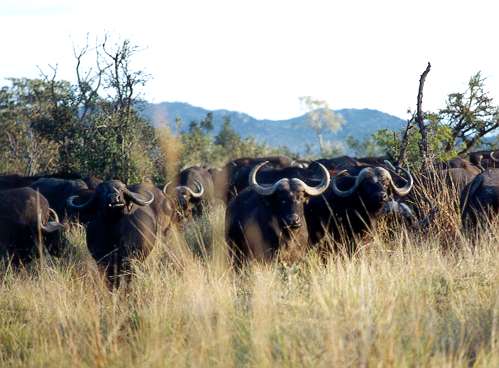 |
Lunch beckoned and then it was time for afternoon siesta. This was interrupted at 15h30 by the customary drum roll. Paul said that he had managed to doze off. Peter said that he hadn't. Ian looked at Peter in amazement and retorted: "Was that an imitation? I walked past and thought it was the chain saw gang in action - the noise stopped and I came back later."A quick tea and then we were off in the dependable Toyota Hilux. Somebody asked whether rucksacks were necessary. Ralph retorted that he felt naked without his. Sections of the road were slushy from the recent rains, which had abated upon our arrival the day before. We drove to and settled for sundowners at the water catchment area. Excitement prevailed as we encountered a herd of up to forty buffalo on the way back. Heads arched upward with curiosity, they gradually approached the vehicle and then suddenly, as if an alarm had been sounded by the ox-peckers present, they thundered off into the thicket, in unison. The sheer might of this procession left us aghast. |
| Thando described three distinct zones which define
one's proximity, when on foot, to animals in the wild. These are the comfort zone,
the recognition zone and the critical zone. Our sightings to date would be described
in terms of the former two, whereas in terms of the latter case, one could potentially be
placed in a life-threatening situation. The remark overheard was that this was the
zone where, depending on the animal concerned, "you mark your territory
involuntarily!" A male sable antelope, jet black with a distinct white face,
underbelly and rump, and long, decurved horns, a rare sighting indeed, was spotted in the
comfort zone, some distance off the road.
We returned to the camp in the best 4 by 4 Land Rover recovery vehicle, by far, showered and were then treated to the culinary delights courtesy of James. Even though I heard the distant roar of a lion, the sounds of the bush did not seem to matter, as I dozed off into oblivion later that evening. |
| Day three |
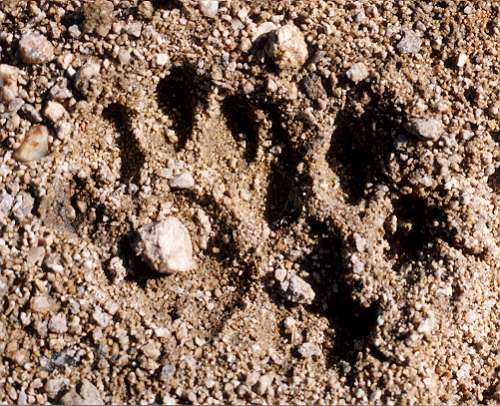 |
The pattern of the previous days' activities was repeated with the customary wake-up call and basin of hot water at the door, except that we set out on foot directly from the gate of the camp. Near a small stream we observed the spoor of lion, giraffe and rhino. Trackers have the ability to distinguish between the spoor of even a lion and lioness, in that the rear of the paw is more rounded in the one case than the other. Once again Paul's foldout chart of animal spoor raised a great deal of interest. We were shown the digging hole of a porcupine, regarded as a delicacy by lion. The "Quick Reference Spoor Guide" for Southern African Animals is produced by Spoors Unlimited Africa in English, with accompanying German translation. It is a must for a hike of this nature! A black rhino feeds on the leaves of a young Tambotie tree, the leaves of which contain a milky fluid. Though poisonous, it does not affect the rhino in any way. We recognised an older example of this tree, as several existed in our camp area as well. It can be used in the making of furniture but is not recommended for "braais". For the record, no indigenous tree wood is used for the purposes of firewood in the camp - all of it is alien and is brought in. |
| Our knowledge was progressed in leaps and bounds as the two able rangers pointed out red bush willow, weeping bush willow, silver cluster leaf, knob thorn and koeboe berry trees, the latter of which berry we tasted. Unlike the previous day where I had remained at the rear of the trail, I realised the enormous advantage of venturing further forward close behind the rangers. Somehow it presented one with the opportunity of spotting game more easily, though we were mere amateurs by comparison. My eyes caught the profile of a lone impala, whereupon I singled by means of a low whistle. Initially motionless, the animal moved on. Thando looked at me, smiled and gave me the thumbs up: "You're getting there", he said. |
| Near the cairn where we stopped for the customary late breakfast, zebra grazed on the distant slopes of a koppie. We shared Thando's joke when we encountered a warthog. He described how "the skin is shared between the front and rear ends of the last creature God created from what was left over". He then grinned cheekily: "When it pulls its eyes shut, the rear tail lifts up". Grey in colour with a thin covering of hairs, wart-like bumps on its head and rather large upward curving tusks, Africa's only diurnal swine, the warthog is often seen in family groups, trotting off briskly with its tail raised swiftly, which serves as a diagnostic trait, and determinedly nonchalant air. Indeed, it is brave when defending its offspring in the face of impending danger. "Oh no, not those drum rolls again!", muttered Scott. I alighted from my bed and heard what I thought were birds having a bath in the basin outside. I opened the door, only to see Ian standing in the doorway, his face covered in shaving cream. "Do you mind not taking my mirror away?", he snarled indignantly. |
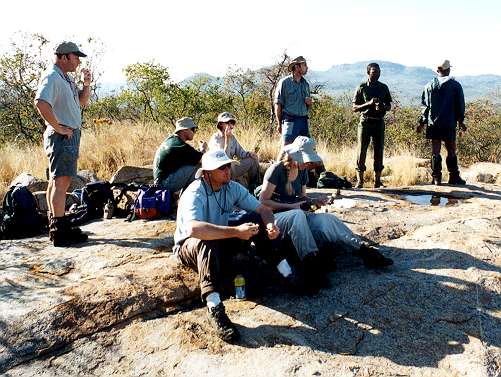 |
| Some had showered and were running out of T-shirts
that afforded some measure of camouflage. I had put on a predominantly black and
white striped T-shirt. "This will have the zebra running after Peter in the rutting
season", came the wisecrack. Julie sported a rock concert T-shirt with the heads of
Elton John and Billy Joel adorning the front. I wished to respond with the remark
"a nice pair, indeed" but thought better of it. Scott's description of an
earlier encounter Stateside as to how he kung-fu'ed a household intruder was still fresh
in my memory! We drove to an area close to a nearby outcrop known as Frans se koppie. We set out on foot and as we progressed along a less direct route at a gentler incline, we encountered a lone white rhino grazing happily amidst the grassy vegetation. Maintaining virtual silence as best we could, the beast, though aware of our presence, seemed unperturbed. This afforded us an excellent photographic opportunity as it basked in the late afternoon sunshine. We pressed on and left our Jurassic friend in peace, as we were aiming for some bushman rock paintings further up. Near the koppie summit, we witnessed a stunning sunset, the sky bathed in a deep red. Anxious not to be caught out in the veld after nightfall, Kally led us down the hillside back to our vehicle. |
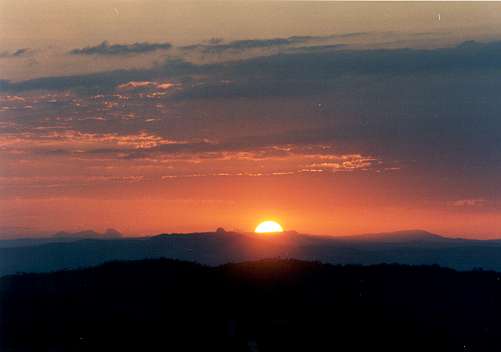 |
I could not resist a humurous extract from skilled writer and former Star newspaper editor Harvey Tyson's book "A walk on the wild side", while he was attempting to photograph a rhino:- "While painstakingly focusing my camera, I noted with interest [our Zulu game guard] Mtetwa filling the screen and passing by. Then I noted with satisfaction that the rhino was no longer a mere dot, but distinguishable, if a little blurred. I refocussed, but the blurring continued. I seemed to be zooming in on this rhino faster than I could focus. Except that I didn't have a zoom lens. I decided to depart. I can't remember when my feet first touched ground, but remember that, in other circumstances, I would have been exhilarated beyond measure by the speed at which I was flying downhill. Suddenly something gripped my arm, pulling me back on to the horn of death. Then it shoved me aside and, as I stumbled, I dived headlong from the path of the rhino - only to find that it was Ben. He was trying to sacrifice my life for his. Mtetwa stood beside me, breathing heavily. The rhino, apparently having trotted only ten paces, had lost interest and was grazing far back behind the lone tree." |
| By the time we arrived back at the camp, it was
dark but not without some drama. Our versatile cook, James, warned us that a bull
elephant had wandered into the camp. Though not aggressive by any means, it was
clearly in must, according to Thando. Bull elephants may mate for the first time
only after twenty years. James resorted to sterner measures after his loud grunts
punctuated by the occasional "Voertsek!" (Afrikaans for "b-----
off!") failed to have the desired effect of convincing old Tusker that he wasn't
welcome and that we wished to have our evening meal in peace. A shot rang out from
Kallie's rifle into the darkness overhead and the elephant eventually wandered off.
We were told that, on a previous trail, a similar situation had arisen when, unbeknown to
James, a lion had found its way into the camp. Needless to say, discretion being the better part of valour, A-frame hut door was shut firmly later that evening. |
| Day four |
| Though we would have liked a further brief walk,
this was unfortunately not to be. We packed and after being treated to a hot
breakfast, we departed for Berg-en-dal. Farewells having been dispensed with, Ralph,
Ian and I passed away the time while waiting for our hired vehicle to be delivered, with
the purchase or two in the curio shop. We wandered along the river embankment
adjacent to Berg-en-dal, sealed off from the lone crocodile basking in the sunshine
down below.
As we headed off in the direction of Bethlehem, Ian was quietly contemplating a return to Kruger with his family. A final mention must go to the proprietress of the Gable Park Guest House at the end of Kerk street in Bethlehem, Elaine Robertson, who made our overnight stop in Bethlehem immensely comfortable. Even though were wished to depart in the early hours of the morning en route back to Cape Town, she graciously prepared a hamper of sandwiches, fruit and yoghurt the evening before, in lieu of the breakfast we would be missing out on. |
|
|
| The outstanding South African publication, Earthyear - The essential Environmental Guide, published bi-annually by Earthyear Environmental Communications, carries an article relating "a Wilderness Walk that ended in tragedy". It is a truly beautiful, well-illustrated magazine, its articles imaginative yet thought-provoking and of an extremely high journalistic standard, dealing, in broad terms, with ecological projects and issues of environmental importance. It has been the recipient of five design awards and ten journalism awards over the years and captivated my interest the moment I plucked a copy from the bookshelf of the local newsagent and paged through the magazine. It ought to be mandatory reading for every home in South Africa. At the meagre price of only R15, it is an giveaway! Get a copy now! |
|
|